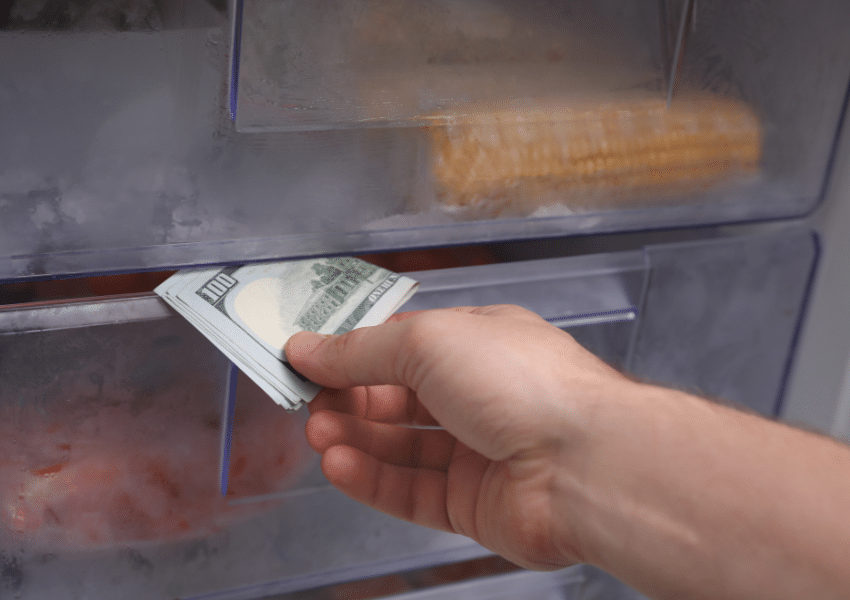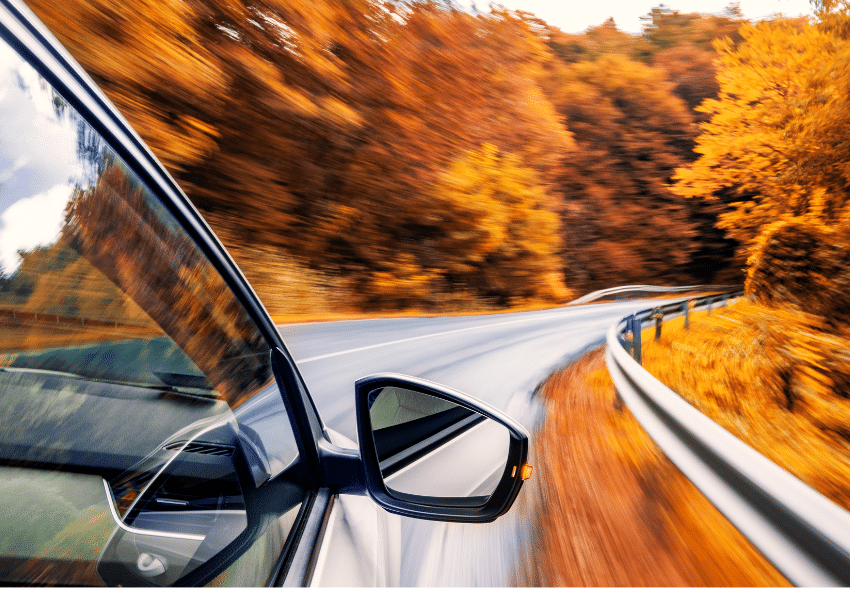
The Worst Place to Stash Your Valuables
Think you’ve found the perfect hiding spot for your cash or jewelry? Think again. From the freezer to the sock drawer, burglars know all the “secret” places homeowners use to stash their valuables. Before you tuck away your treasures in plain sight, learn which hiding places offer false security — and where your valuables will truly be safe.
Front Door
We’ve all heard the advice about keeping a spare key “just in case,” but hiding one near your front door is practically an open invitation. The doormat, flowerpot, mailbox, or fake rock –these are the first places a burglar will check. If you need to keep an extra key, leave it with a trusted neighbor instead.
Entryway
Your entry table may be the perfect place for dropping your car keys, wallet, or spare cash when you walk in, but it’s also the first stop for an intruder. Those items are quick to grab and easy to carry. A thief could be in and out of your home in under a minute with your keys, ID, and bank cards in hand.
Bedrooms
Burglars make a beeline for the master bedroom because they know that’s where people store their most valuable items — cash, jewelry, and small electronics. They’ll check dresser drawers, armoires, sock drawers, and even the space under your mattress. Suitcases and storage boxes? Those are fair game, too. The very spots that are most convenient for you are the ones they will check.
Freezer
Think your freezer is foolproof? Think again. Many homeowners wrap cash or jewelry in plastic and tuck it behind the frozen vegetables. But this “clever” hiding place is common knowledge among burglars. If it’s easy for you to access, it’s easy for them to find.
Bathrooms
Your bathroom medicine cabinet may seem like a private place, but it’s often one of the first areas a thief will check — especially if they’re looking for prescription drugs to sell. Don’t keep cash or jewelry there either; it’s too easy to reach.
Cookie Jar
It might seem like a sweet spot to stash your grocery money, but thieves know this classic trick. The same goes for flour tins and coffee canisters. If it’s in plain sight in the kitchen, assume it’s on a burglar’s radar.
Home Office
Your office is a goldmine for identity thieves. Computers, passports, checkbooks, and tax forms can all be used to steal your identity or drain your accounts. Keep sensitive documents locked away and back up important files to a secure cloud account.
Portable Safes
A small safe can keep kids or guests out of your valuables, but it won’t stop a thief from carrying the whole thing out the door. Unless your safe is bolted to the floor or wall, it’s just another box waiting to be picked up and opened later.
Other Bad Spots
Anywhere damp, dirty, or difficult to monitor is also a poor choice. Inside toilet tanks, for example, may seem clever, but the moisture can ruin documents and cash.
Where to Hide Your Valuables Instead
The best hiding places are the ones that require effort to access or don’t make sense for a thief to bother with. Think inconvenient, hidden, or disguised. Here are some ideas.
Trash Can with a False Bottom
A cleverly designed trash can with a hidden compartment can be a surprisingly effective deterrent. Thieves are unlikely to rummage through garbage. Just make sure your valuables are sealed against moisture — and don’t accidentally toss them out on trash day!
Fake Wall Outlets
You can purchase wall outlets that look completely real but pull out to reveal a small hidden compartment. They’re perfect for storing cash, jewelry, or small documents. Just be sure the outlet isn’t connected to any wiring.
Hidden Household Items
Fake food cans or containers designed to mimic ordinary products — like shaving cream or soup — are a discreet way to hide valuables. You can even make your own by hollowing out real cans. Just be careful to make them look authentic, and don’t place them in high-traffic areas where someone might mistake them for the real thing.
Structural Hiding Spots
If you’re handy, consider creating built-in hiding spaces behind removable panels or trim. Hollowed-out wainscoting, door jambs, or floorboards can be excellent concealment spots. Pre-made versions are also available for purchase and can be installed without major renovations.
Books and VHS Cases
A hollowed-out book on a crowded bookshelf — or an old VHS tape in a dusty box — won’t draw a second glance. Just don’t use a book or a tape case you might mistakenly donate.
Storage Bins
Large, unlabeled bins can attract attention, so disguise your valuables among ordinary items. Label bins with dull titles like “Old School Projects,” “Holiday Décor,” or “Winter Clothes.” Even if burglars do open a few, they’re unlikely to dig deep through boxes of tinsel or kids’ art supplies.
Kids’ Bedrooms
While the master bedroom is a prime target, thieves usually skip children’s bedrooms. Consider stashing your valuables in a box on a high shelf in the closet. Further protect it with a misleading label.
Add an Extra Layer of Security
Even the best hiding spots can’t protect your valuables completely. Strengthen your security by:
- Installing a home security system with cameras and alarms to deter burglars.
- Using motion-sensor lighting around entry points to discourage nighttime intrusions.
- Keeping your valuables insured through your homeowner’s or renter’s policy so you’re financially protected even if the worst happens.
By avoiding the most obvious hiding places and thinking creatively about security, you can protect your valuables and your peace of mind.
This article is furnished by California Casualty, providing auto and home insurance to educators, law enforcement officers, firefighters, and nurses. Get a quote at 1.866.704.8614 or www.calcas.com.

Fall Driving Hazards
As the temperature drops and the leaves begin to fall, road conditions change in ways that can catch even experienced drivers off guard. Deer are more active, wet leaves can be as slick as ice, and shorter days mean more time driving in the dark. Here’s what to watch for this season—and how to steer clear of danger.
Watch for Deer on the Move
You’ll often see deer during dawn and dusk at the side of the road during the fall months. That’s when they’re foraging for food. Keep a sharp eye out near wooded areas and where deer crossing signs are posted. If you must stop, use your hazard lights to alert other drivers. A few tips to remember:
- Deer travel in groups; if you see one, more are likely close behind.
- Avoid swerving. Swerving can confuse the animal and cause them to run in the wrong direction. It also can put you in the path of oncoming traffic. Instead, slow down in a controlled manner and let the deer pass.
- Know your insurance coverage. Damage from hitting a deer is typically covered by comprehensive insurance—not liability. Check to see if your policy includes it.
Beware of Leaf Trouble
Fallen leaves may look pretty, but they can cause more problems than you might think. Here are just some of the hazards.
Wet Leaves
When wet, leaves can be as slick as ice. They can also block roadside drains, creating puddles and hidden hydroplaning risks. make sure your tires are properly inflated to help maintain grip. If you drive over wet leaves and your tires lose traction:
- Don’t slam the brakes. Ease off the gas. If you need to brake, use a light pumping motion.
- Steer gently in the direction you want to go.
- When you feel the tires connect with the road, you can proceed as normal.
Dry Leaves
Dry leaves and hot car parts don’t mix. Avoid parking over leaf piles. Your exhaust or catalytic converter can ignite them, even if the engine’s off. Also, keep leaves away from garages and undercarriages so there’s no chance that they can cause trouble.
Around Your Car
Leaves can clog air filters, radiators, and windshield gullies. Remove them regularly to prevent foul-smelling moisture buildup and potential damage to your car’s paint or electronics.
Hidden Potholes and Road Hazards
A thick carpet of leaves — or later, snow — can hide potholes, curbs, and lane markings. Drive cautiously and maintain extra distance from the car ahead. Slow down near leaf piles; kids sometimes play in them. And remember, some drivers are more focused on the foliage than the road, so stay alert.
Adjust to Early Darkness
When daylight savings time ends, you may find yourself driving home in the dark more often. Make sure your headlights and brake lights are working properly. Darkness also affects depth perception, so give yourself more space and time to react.
- Drive at a speed where you can stop within your headlight range.
- Use high beams when safe and dim them for oncoming cars.
- Watch for pedestrians and pets, especially during dusk and dawn when visibility is lowest.
Reduce Sun Glare
The sun sits lower in the sky during fall, which means more blinding glare during morning and evening commutes. Keep sunglasses handy, use your visor, and clean your windshield inside and out — streaks and dust scatter light and make it harder to see. Replace your windshield wipers as needed. If glare is intense, slow down and increase your following distance.
Handle Fog and Frost the Right Way
Foggy and frosty fall mornings reduce visibility fast. They can sneak up on your car’s windows as temperatures fluctuate. Don’t drive with foggy or icy glass. Use your defroster and a scraper or try a DIY de-icer (three parts vinegar to one part water).
- If it’s foggy, engage your fog lights to increase visibility. Don’t use your high beams; they have the opposite effect — reflecting off the fog and temporarily blinding you.
- Turn on your defroster or crack a window to balance temperatures and prevent your windshield from fogging.
- Remember: frost on your windshield means it could also be on bridges and overpasses, which freeze first. Proceed with caution.
Keep an Eye on Tire Pressure
Cooler weather means lower tire pressure. For every 10-degree drop in temperature, tires can lose about one PSI. Low pressure affects traction, braking, and fuel efficiency, so check often and inflate your tires as needed.
Share the Road with School Buses
Fall also means back-to-school season. Be aware of how that impacts traffic safety and know the rules about school buses:
- Yellow flashing lights: The bus is preparing to stop.
- Red lights and extended stop arm: The bus has stopped for children.
- Always stop — never pass. Watch for kids crossing the street or walking near the bus and remember that visibility is lower in early morning and late afternoon light.
Don’t Forget Your Insurance
Even the most cautious drivers can’t prevent every accident. Make sure your auto insurance is up to date so that you have peace of mind when the unexpected happens.
Safe travels this season!
This article is furnished by California Casualty, providing auto and home insurance to educators, law enforcement officers, firefighters, and nurses. Get a quote at 1.866.704.8614 or www.calcas.com.

House Hunting: What to Look for Beyond Curb Appeal
That picture-perfect porch or freshly painted shutters might catch your eye but looks aren’t everything when it comes to house hunting. The smartest buyers dig deeper, considering how a home’s layout will work day-to-day, the strength of the neighborhood, and how well the property will hold its value over time. After all, the best home isn’t just the one that charms you at first glance—it’s the one that pays off in the long run.
Here are some key things to look for beyond curb appeal when you’re searching for your next home.
Natural Light
A bright, airy space feels welcoming—and it can save you money on utilities by cutting down the need for artificial lighting. As you walk through a potential home, notice the direction of the windows and how the sunlight filters into each room. Morning light may make a kitchen cheerful, while evening sun could make a family room glow. Don’t just admire the view—test the windows. If they stick or are difficult to open, it might indicate foundation or insulation issues. Outdated windows may also need replacing, which can be a costly project.
Storage Space
It’s easy to fall in love with a home during a tour, only to realize later that there’s nowhere to put your holiday decorations, sports equipment, or bulk groceries. Storage goes beyond closets—think attic, basement, garage, pantry, and even built-in cabinetry. Ask yourself whether the available storage fits not only your current lifestyle but also your future needs. After all, homes have a way of filling up quickly.
Layout and Flow
The layout of a home impacts your daily routine more than you might realize. Picture yourself moving through the space: is the kitchen conveniently located near the dining area? Is there room to entertain friends, host family gatherings, or create a home office if you need one? Pay attention to how the rooms connect. An awkward floor plan can make everyday life feel more complicated, while a well-designed layout adds comfort and efficiency.
Noise Levels
Silence is golden—or at least, peace and quiet can be. While touring, pause and simply listen. Do you hear traffic, barking dogs, or nearby train whistles? Inside, thin walls may let in sound from neighbors or other parts of the house. For a more complete picture, ask future neighbors about noise at different times of day. What’s peaceful during an afternoon showing might sound very different on a Saturday night.
Odors and Air Quality
Your nose knows. Strong odors can signal deeper problems, like water damage, frequently flood basements, mildew, or smoke. Musty smells might point to leaks or poor ventilation, while pet accidents or cigarette smoke can be stubborn to remove. Air quality is not only a comfort issue—it’s a health consideration. If something smells off, take it seriously and investigate further.
Functionality and Condition
Think about whether the home is move-in ready or if you’ll need to tackle renovations before unpacking boxes. Check appliances to ensure they’re in working order. Test faucets, light switches, and outlets. Little things add up, and repairs can quickly turn a “dream home” into a financial drain if you’re not prepared.
Foundation and Structural Issues
A beautiful exterior can hide serious problems. Look for cracks in the basement walls or around the outside of the home. Uneven floors, sticking doors, or gaps in window frames can also be red flags. While not every crack is cause for alarm, structural concerns are best evaluated by a professional inspector before you make an offer.
Features and Maintenance
Extra features can be both a blessing and a burden. A spacious lawn may look like the perfect play area, but it will need regular mowing and landscaping. A pool can be fun in the summer, but it comes with ongoing maintenance, insurance considerations, and added liability. Consider carefully which features enhance your lifestyle and which may turn into costly chores.
School District
Even if you don’t have children, the quality of the local schools impacts property values. Homes in sought-after school districts tend to hold value better and sell more quickly. If kids are in your present—or your future—it’s an even more critical factor. Research test scores, extracurricular offerings, and community reputation to make an informed decision.
Long-Term Value
Buying a home is one of the largest investments you’ll make, so think long term. Look for homes in neighborhoods where property values are trending upward. A smart rule of thumb: buy the lowest-priced home in the best neighborhood you can afford. Over time, that decision could pay off with significant equity growth.
Budget and Affordability
Before you fall for any home, take a hard look at your budget. Factor in more than just the down payment and monthly mortgage. Closing costs, utilities, property taxes, home insurance, and future repairs all add to the bottom line. Don’t forget the cost of a professional inspection—it’s money well spent to avoid surprises later. Getting pre-approved for a mortgage helps you know exactly what you can afford, and protecting your investment with the right insurance ensures peace of mind.
The Bottom Line
Curb appeal matters—it’s often what draws you to a home in the first place. But the smartest house hunters know to dig deeper. Natural light, storage, layout, functionality, neighborhood trends, and long-term value all play a part in making a home the right fit. By asking the right questions and looking beyond the surface, you’ll set yourself up not only for a smooth move-in but also for a smart financial future.
This article is furnished by California Casualty, providing auto and home insurance to educators, law enforcement officers, firefighters, and nurses. Get a quote at 1.866.704.8614 or www.calcas.com.

Brakes 101: What Every Driver Should Know About Staying Safe on the Road
When it comes to keeping you safe behind the wheel, nothing works harder than your brakes. They’re your car’s first line of defense against accidents, yet most drivers don’t think about them until something goes wrong—a squeak, a grind, or that sinking feeling when the pedal doesn’t respond like it should.
The good news? You don’t need to be a car expert to understand how brakes work or how to spot trouble before it turns into a safety issue. With a little knowledge, you can keep your brakes in top shape and give yourself peace of mind every time you drive.
How Do Brakes Actually Work?
At their core, brakes use one simple idea: friction. When you press your foot on the brake pedal, you’re triggering a hydraulic system—a system powered by fluid—that pushes brake pads or brake shoes against a spinning surface attached to your wheels. That pressure and friction are what slow your car down.
Think of it like riding a bicycle. When you squeeze the hand brakes, the pads press against the rim of the wheel, creating friction that makes the bike stop. Your car brakes work on the same principle, just on a larger and more powerful scale.
Most modern cars also have power-assisted brakes, which make it easier for you to press down, and an anti-lock braking system (ABS), which prevents the wheels from locking up during sudden stops. That keeps your car more stable and easier to steer in an emergency.
Disc vs. Drum: The Two Main Types of Brakes
Most vehicles on the road today use a hydraulic braking system with either disc brakes, drum brakes, or a combination of both.
- Disc Brakes: These are the most common, especially on the front wheels (which handle most of the stopping power). A spinning disc, called a rotor, is clamped by a caliper holding brake pads. When you press the brake pedal, the pads squeeze the rotor, creating friction to slow the wheel.
- Drum Brakes: These are more often found on rear wheels. Inside the brake drum, brake shoes are pressed outward by pistons when you hit the brakes, rubbing against the drum to slow the car.
You don’t need to memorize the mechanics, but it helps to know that both systems rely on brake fluid, pads or shoes, and the principle of friction to get the job done.
Warning Signs Your Brakes Need Attention
Brakes give you plenty of signals before they fail completely. The key is to notice them early:
- Strange Noises: A squeal often means your brake pads are wearing thin. A grinding sound could mean the pads are worn down completely, with metal scraping against metal.
- Soft or Spongy Pedal: If the brake pedal sinks toward the floor or feels unusually soft, it may signal a leak in the brake system or air in the brake lines.
- Car Pulling to One Side When Braking: If your vehicle veers left or right when braking, it could be uneven brake wear, contaminated fluid, or a problem with the brake linings.
- Dashboard Warning Lights: Don’t ignore that glowing brake light. It’s your car’s way of asking for help.
If you notice any of these symptoms, it’s time to schedule a brake check before things get worse.
Simple Brake Maintenance Tips
You don’t need to be a mechanic to stay on top of basic brake care. A little attention can go a long way toward preventing costly repairs and keeping you safe. Here are some practical steps:
- Check Brake Pads: Brake pads wear down over time. If they’re less than ¼ inch thick, it’s time to replace them. Worn pads reduce your stopping power and can damage other parts of the braking system.
- Watch for Grease or Debris: Brake pads should be clean and dry. Grease or oil on them can reduce friction, making it harder to stop.
- Brake Fluid: Your mechanic should check the level and condition of your brake fluid regularly. Fresh brake fluid is clear or light in color. Dark or dirty fluid should be replaced.
- Rotors and Drums: Look for signs of grooves, cracks, or warping. Depending on the severity, they may need to be resurfaced or replaced.
- Brake Lines: Over time, brake lines can develop leaks from corrosion or damage. Any leak in the system reduces braking power and must be fixed immediately.
A good rule of thumb is to have your brakes inspected at least once a year—or sooner if you notice any changes in how they feel or sound. The cost of regular maintenance is small compared to the expense (and stress) of major repairs, not to mention the potential consequences of an accident.
Brakes may not be the flashiest part of your car, but they’re among the most important. Knowing how they work, spotting warning signs early, and keeping up with maintenance can give you confidence on the road and keep you—and your passengers—safe.
Of course, even the best brakes can’t prevent every unexpected situation. That’s where the right insurance comes in. Just as your brakes protect you in the moment, good coverage protects you afterward—helping you recover from accidents, repairs, or losses. Together, brake care and the right insurance give you the peace of mind to enjoy the drive, knowing you’re fully protected.
This article is furnished by California Casualty, providing auto and home insurance to educators, law enforcement officers, firefighters, and nurses. Get a quote at 1.866.704.8614 or www.calcas.com.
